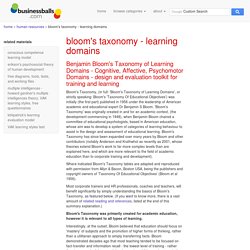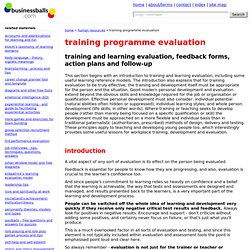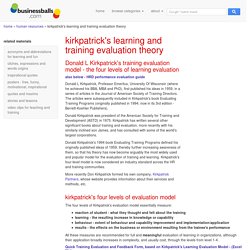

Kirkpatrick's Four-Level Training Model - Team Management Training From MindTools. Analyzing Training Effectiveness Evaluate training effectively. © iStockphoto/Jeryco If you deliver training for your team or your organization, then you probably know how important it is to measure its effectiveness.

After all, you don't want to spend time or money on training that doesn't provide a good return. This is where Kirkpatrick's Four-Level Training Evaluation Model can help you objectively analyze the effectiveness and impact of your training, so that you can improve it in the future. In this article, we'll look at each of the Kirkpatrick four levels, and we'll examine how you can apply the model to evaluate training.
The Four Levels Donald Kirkpatrick, Professor Emeritus at the University of Wisconsin and past president of the American Society for Training and Development (ASTD), first published his Four-Level Training Evaluation Model in 1959, in the US Training and Development Journal. The four levels are: Reaction.Learning.Behavior.Results. Level 1: Reaction Level 2: Learning. Bloom's taxonomy of learning domains - bloom's learning model, for teaching, lesson plans, training cousres design planning and evaluation. Development of bloom's taxonomy Benjamin S Bloom (1913-99) attained degrees at Pennsylvania State University in 1935.

He joined the Department of Education at the University of Chicago in 1940 and attained a PhD in Education in 1942, during which time he specialised in examining. Here he met his mentor Ralph Tyler with whom he first began to develop his ideas for developing a system (or 'taxonomy') of specifications to enable educational training and learning objectives to be planned and measured properly - improving the effectiveness of developing 'mastery' instead of simply transferring facts for mindless recall. Bloom continued to develop the Learning Taxonomy model through the 1960's, and was appointed Charles H Swift Distinguished Service Professor at Chicago in 1970.
He served as adviser on education to several overseas governments including of Israel and India. explanation of bloom's taxonomy bloom's taxonomy definitions bloom's taxonomy overview N.B. In conclusion see also. Trainingevaluationtools. Training programme evaluation - training measurement techniques, examples, tips - learning and development measurement and assessment. Home » human resources » training programme evaluation training and learning evaluation, feedback forms, action plans and follow-up This section begins with an introduction to training and learning evaluation, including some useful learning reference models.

The introduction also explains that for training evaluation to be truly effective, the training and development itself must be appropriate for the person and the situation. Good modern personal development and evaluation extend beyond the obvious skills and knowledge required for the job or organisation or qualification. Effective personal development must also consider: individual potential (natural abilities often hidden or suppressed); individual learning styles; and whole person development (life skills, in other words).
Introduction A vital aspect of any sort of evaluation is its effect on the person being evaluated. There are other training evaluation working files on the free resources page. And back at work, N.B. 1 - do nothing. Donald kirkpatrick's learning evaluation theory - a training and learning measurement, evaluations and assessments model. Donald L Kirkpatrick's training evaluation model - the four levels of learning evaluation also below - HRD performance evaluation guide Donald L Kirkpatrick, Professor Emeritus, University Of Wisconsin (where he achieved his BBA, MBA and PhD), first published his ideas in 1959, in a series of articles in the Journal of American Society of Training Directors.

The articles were subsequently included in Kirkpatrick's book Evaluating Training Programs (originally published in 1994; now in its 3rd edition - Berrett-Koehler Publishers). Donald Kirkpatrick was president of the American Society for Training and Development (ASTD) in 1975. Kirkpatrick has written several other significant books about training and evaluation, more recently with his similarly inclined son James, and has consulted with some of the world's largest corporations. More recently Don Kirkpatrick formed his own company, Kirkpatrick Partners, whose website provides information about their services and methods, etc. see also.